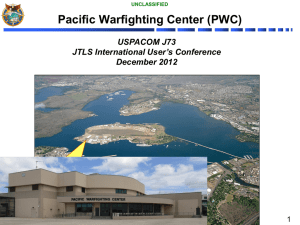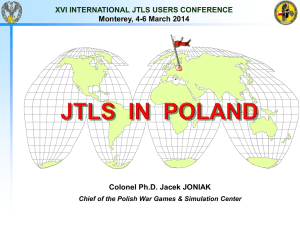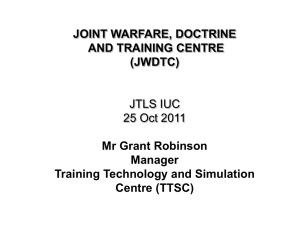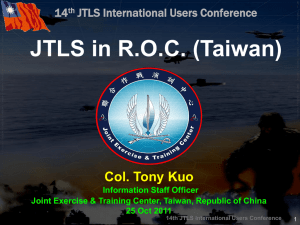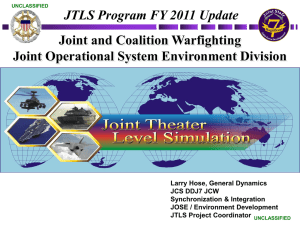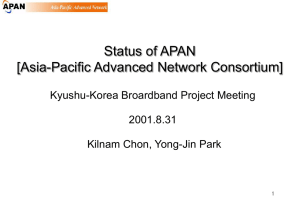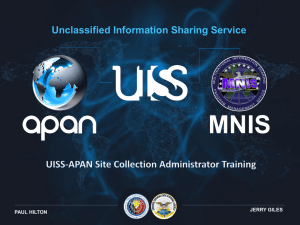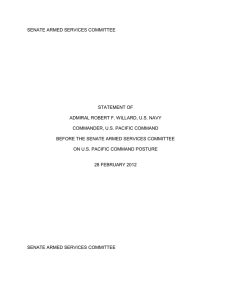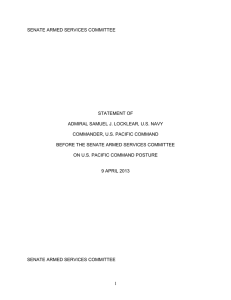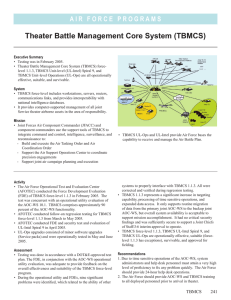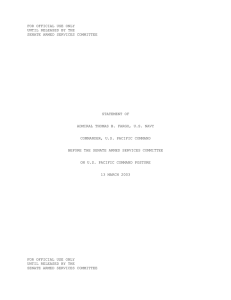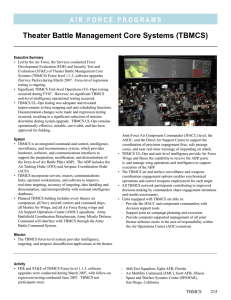Document
advertisement
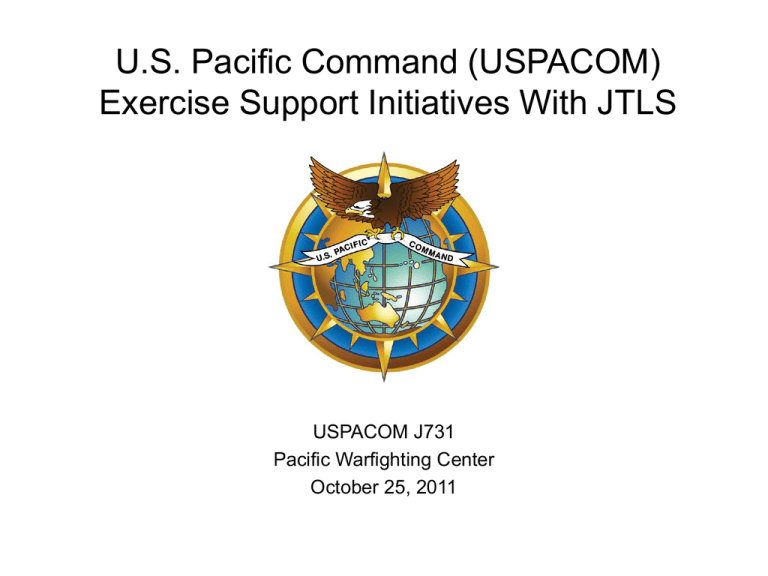
U.S. Pacific Command (USPACOM) Exercise Support Initiatives With JTLS USPACOM J731 Pacific Warfighting Center October 25, 2011 Agenda • • • • • Review of Balikatan 2011 Exercise Review of Exercise KEEN EDGE Initiatives PACOM Sponsored JTLS updates Planned Events Introduction to M&S Community within the All Partners Access Network (APAN) Balikatan 2011 Exercise Summary Balikatan 2011 is a Republic of the Philippines-U.S. bilateral military humanitarian assistance and training exercise held in the Philippines. U.S. Army Pacific (USARPAC), the Army Service Component Command in the U.S. Pacific Command (USPACOM) area of responsibility, is executive agent for Balikatan. About 6,000 U.S. service members will train with Armed Forces of the Philippines personnel during the joint bilateral exercise. Components of Balikatan include civil-military operations, field training exercises and a command post exercise. This was the 27th exercise in the Balikatan series and held under the auspices of the Mutual Defense Treaty and Visiting Forces Agreement. Balikatan demonstrates USARPAC's ability to support multiple contingencies throughout the Pacific Theater. USARPAC's Contingency Command Post deployed from Fort Shafter, Hawaii, to validate its capability as a trained and ready team that can support Pacific-wide operations. Bilateral training is vital to maintaining readiness capabilities for both the U.S. and Philippine armed forces. Balikatan sustains the long-term security assistance relationship between the Republic of the Philippines and the United States. Balikatan increases interoperability between military forces and enables them to provide relief and assistance in the event of natural disasters and other crises. The government of the Republic of the Philippines and the United States have a long relationship of working together. This partnership includes a 59-year-old Mutual Defense Treaty. --from USARPAC.ARMY.MIL , US Army Pacific Balikatan Exercise Highlights • Full Spectrum Operations • First use of JTLS during a BK Command Post Exercise (CPX); simulation architecture included 8 JTLS workstations (Response Cells) • Artificial Terrain • Naval and Ground focus UNCLASSIFIED Malinidos Scenario Peixe Grande Malinidos San Rafael Torres KEEN EDGE Initiatives • Multi-Network Operations – US Only and Bilateral Networks o Common Operational Picture (COP) o Simulation Architecture stimulates Command and Control systems • Force Flow Representation – – – On the COP Dynamic Logistics Planning Tools • JTLS linkage to Mobility/Logistics Suite Objective – JTLS to Mobility/Log Suite • Initial schedule from CAMPS in GDSS • JTLS “reads” GDSS and TBMCS • JTLS reports back to GDSS and TBMCS TRANSCOM Level 4 Data JOPES PID AMC SMS Logistics CAMPS ITV STRAT Lift Missions GCCS-J All Airlift Missions Schedule (Orders) SIPRNET Flight Status AK COP AOC GDSS AK/AD TBMCS Level 2 Data Theater Lift Missions ATO AK/AD SA Only JTLS AD CENTRIXS AMD DCAMPS Notional Diagram TBMCS ATO USPACOM Sponsored JTLS Updates • • • • • STAGE Approved Estimating Def req. Def req. DESCRIPTION Implement JTLS / GDSS2 Self Reporting Ships (link 16) Combat Action Alert Hide Combat Systems in Bunkers STATUS In progress not started not started not started Planned Events JAN 2012 KEEN EDGE Bilateral CPX FEB 2012† COBRA GOLD Multi-National CPX MAY 2012‡ TERMINAL FURY Unilateral CPX † JCW supported ‡ PACOM J73 – PWC led / JCW limited support Deployment/Combat Ops Peace Enforcement Tier 1 / COP Driver USPACOM Sponsored M&S Community • Community URL and Purpose: • https://community.apan.org/jtls/ • https://community.apan.org/default.aspx • The purpose for the M&S Community within APAN is to enable M&S trainers, users, and stakeholders worldwide to collaborate and share information to solve common problems and challenges, leverage M&S expertise, and ask for help / resources. USPACOM Sponsored M&S Community USPACOM Sponsored M&S Community Questions? USPACOM J73 Mike Fagundes michael.fagundes@apan-info.net 808-472-7766 BACK UP SLIDES All Partners Access Network (APAN) The All Partners Access Network (APAN) provides for effective information exchange and collaboration between the United States Department of Defense (DOD) and any external country, organization, agency or individual that does not have ready access to traditional DOD systems and networks. It enables professional networking and communication, increases situational awareness, establishes pre-defined communications channels, relationships and information work flows, and provides a forum for sharing lessons learned and best practices in a wide variety of contexts including crisis response, humanitarian assistance, disaster relief, and training and exercises. Benefits include decreased response times, greater coordination, information transparency and broader cross-organizational knowledge visibility. While encouraging the open and easy exchange of information, APAN also seeks to ensure the protection of sensitive information like users’ identities and personal communications. The All Partners Access Network history can be traced back to 1997 when the Virtual Information Center (VIC) was established with the mission of conducting research using public domain materials for the Commander of the U.S. Pacific Command (USPACOM) and his staff. Admiral Dennis C. Blair, then Commander of USPACOM, recognized the value of utilizing the same type of web-based technology used in the VIC to help meet his regional security cooperation initiatives. In March 2000, the Asia-Pacific Area Network, a non-dot-mil (non-military) commercial internet portal, was stood up to enable online communication and information sharing. Over the years, APAN’s mission has grown to support global Humanitarian Assistance / Disaster Relief HA/DR operations, partnership building, joint exercises, conferences, table-top events, and are currently at the crossroad to becoming an Enterprise DOD Unclassified Information Sharing Program. In response to APAN’s expanding global customer base, in February 2010, APAN was renamed the All Partners Access Network. APAN's unique organizational culture based on innovation, resourcefulness and customer service has made it a leader in unclassified information sharing and collaboration throughout the DOD.
